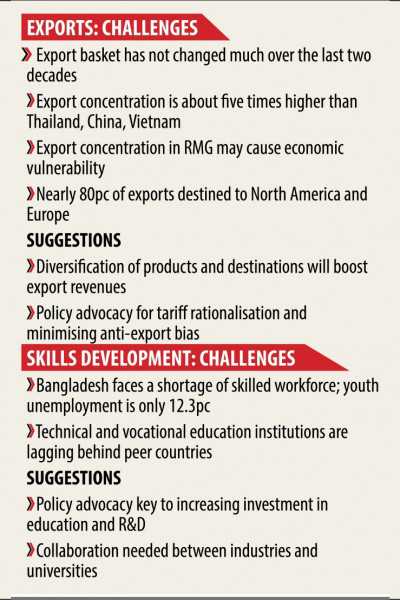Diversify exports at haste

Image collected
Export concentration on just one product, garment, and a few destinations may cause economic vulnerabilities in the economy, said Shams Mahmud, the newly elected president of the Dhaka Chamber of Commerce and Industry (DCCI), yesterday.
Garment accounts for about 84 per cent of Bangladesh’s export earnings now.
Nearly 80 per cent of exports are destined to North America and Europe and product sophistication has remained almost static, which are also a major concern for the economy in the long run, Mahmud said at a press briefing in his office in Dhaka.
Export concentration in Bangladesh is about five times higher than that of other export-driven economies such as Thailand, China and Vietnam, he said.
Broadening the export product base, destination and quality, diversification can stabilise and expand export revenues and boost economic growth.
Partnering of trade through signing deals in bilateral or multilateral system with countries, trade blocs, association and trade facilitation for creating new export markets can create opportunities for Bangladesh, he said.
He suggested for policy advocacy -- like the government did in case of garment -- to promote other export sectors.
Bonded warehouse facility and back-to-back letters of credit can be extended to the leather sector, while tax rebate can be given for new technology adoption in the light engineering, shipbuilding, jute and jute-made goods, agro-processing sectors.
The Bangladesh Standards & Testing Institution must be given a quality standard testing facility to boost agro exports.
Bangladesh faces a shortage of skilled workforce while youth unemployment is staggering at 12.3 percent.
“Our technical and vocational education institutions are lagging behind our peer countries in developing market driven skills,” he added.
About 12 million expatriates contributed $16.42 billion remittance in fiscal 2018-19.
In terms of the average income of migrant workforce, Bangladesh is way behind regional peers like India and Sri Lanka due to lack of skilled labour force and professionals.
According to a study by Access to Information (a2i), about 40 percent of all employment of Bangladesh from garment, agro food, furniture, tourism and hospitality, and leather and footwear sectors are vulnerable due to automation, he said.
He also suggested for policy advocacy for increasing investment in the education sector and research and development.
He sought collaboration between industries and universities through research and innovation to update and re-design education curriculum based on market demand to equip graduates with the required skills.
Considering the critical, regional and sub-regional state, Bangladesh has huge trade and investment importance as the gateway to ASEAN and China led Belt and Road Initiative (BRI).
ASEAN and BRI initiatives are very important as both are covering for sustainable export market, economic connectivity, leverage in the changing geo-economic context in this region.
Currently, trade is about $9 billion between ASEAN and Bangladesh.
Bangladesh is not gaining sufficient market access to Africa, North America and Asia.
To ensure a win-win situation with major trading partners, effective economic diplomacy is needed to address the tariff, non-tariff and post economic graduation challenges to sustain economic cooperation with relevant economies.
He suggested taking measures so that Bangladesh can be eligible for the Generalised System of Preferences Plus status by 2024 to the EU.
The VAT is not calculated according to the ratio of value addition in a product and VAT rebate is not allowed at 5 percent, 7 percent, 7.5 percent and 10 percent.
Source: https://www.thedailystar.net
Tags :
Previous Story
- Govt efforts on doing business, FDI inflow not...
- Economy not gloomy, but challenges remain: DCCI
- Good governance stressed for disciplined financial market
- Credit lines stressed for maximizing export competitiveness
- Industries minister emphasizes improving product, services quality
- Corporate tax: Bangladeshi entrepreneurs pay highest in South...
- DCCI for separate SME bank
- Study suggests formalizing electric vehicles for employment and...